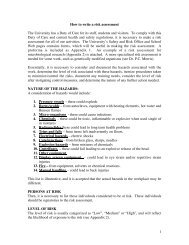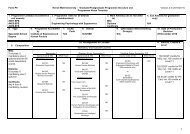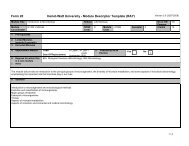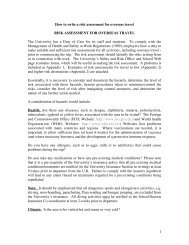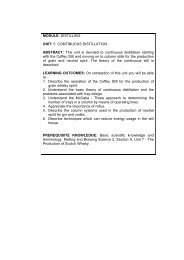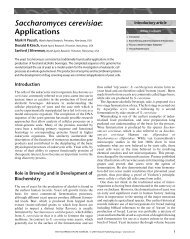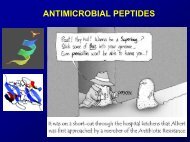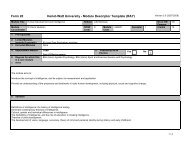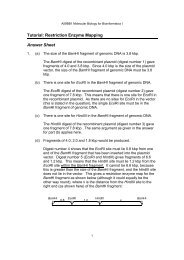Chapter 11 Production of Scotch and Irish whiskies: their history and ...
Chapter 11 Production of Scotch and Irish whiskies: their history and ...
Chapter 11 Production of Scotch and Irish whiskies: their history and ...
You also want an ePaper? Increase the reach of your titles
YUMPU automatically turns print PDFs into web optimized ePapers that Google loves.
<strong>Production</strong> <strong>of</strong> <strong>Scotch</strong> <strong>and</strong> <strong>Irish</strong> <strong>whiskies</strong>: <strong>their</strong> <strong>history</strong> <strong>and</strong> evolution 153the mash. Table 3 shows changes in theconcentrations <strong>of</strong> Gram-negative <strong>and</strong> Grampositivebacteria <strong>and</strong> (separately) <strong>of</strong> lactobacilliduring fermentation <strong>of</strong> a minimally-infected mash<strong>and</strong> <strong>of</strong> a heavily-infected mash. The time course<strong>of</strong> fermentation <strong>of</strong> an unacceptably-infected maltdistillery mash (Figure 8) shows, in comparisonwith similar data for fermentation <strong>of</strong> anacceptable mash (Figure 6), a greater rise in theacid content <strong>of</strong> the mash after about 35 hrs <strong>and</strong>a lower optical rotation <strong>of</strong> the mash after about40 hrs. In the fermentations there is <strong>of</strong>ten adifference <strong>of</strong> up to 4 hrs from the time a rise inthe acid content is detected to the point whenthe pH value <strong>of</strong> the fermentation begins to fall.Dolan (1976) attributes this to the bufferingcapacity <strong>of</strong> the mash. The data in Table 4 showthe effect <strong>of</strong> different levels <strong>of</strong> infection after 30hrs fermentation <strong>of</strong> a malt distillery mash on spirityield <strong>and</strong> the associated financial losses to thedistiller. Dolan (1976) recommends upper limits<strong>of</strong> 1,500 bacteria, 50 Gram-positive <strong>and</strong> 10 lacticacid-producing bacteria per million yeast cells inthe mash at the start <strong>of</strong> fermentation.Much less has been published on the effect<strong>of</strong> retaining solid material in the fermenting mash.However, marine microbiologists have longknown that the presence <strong>of</strong> solid particles in aliquid medium can affect bacterial growth,probably because <strong>of</strong> the concentration <strong>of</strong>nutrients at the solid-liquid interface (Heukelekian<strong>and</strong> Heller, 1940; Zobell, 1943). Moreover,Cromwell <strong>and</strong> Guymon (1963) found that formation<strong>of</strong> higher alcohols during fermentation <strong>of</strong>grape juice is stimulated by the presence <strong>of</strong> grapeskins or inert solids. Beech (1972) made similarobservations on cider fermentations. Merritt(1967), in the only detailed report on the role <strong>of</strong>solids in whisky distillery fermentations, states thata dry solid concentration <strong>of</strong> 50 mg/100 ml mighttypically be expected, although much will clearlydepend on the design <strong>of</strong> the mash tuns used inindividual distilleries. Merritt went on to reportthat a concentration <strong>of</strong> dry solids as low as 5mg/100 ml causes an increase in yeast growth,<strong>and</strong> that solids also enhance the rate <strong>of</strong>production <strong>of</strong> ethanol <strong>and</strong> glycerol. There wasalso an effect on production <strong>of</strong> higher alcoholsby the yeast (Table 5). With the possibleexception <strong>of</strong> n-propanol, production <strong>of</strong> all <strong>of</strong> themajor higher alcohols was increased in thepresence <strong>of</strong> solids, the effect being particularlynoticeable with isobutanol <strong>and</strong> 2-methylbutanol.Figure 8. Changes in specific gravity, optical rotation, pH value <strong>and</strong> acidity during fermentation <strong>of</strong> a <strong>Scotch</strong> maltwhisky mash containing an unacceptably high concentration <strong>of</strong> bacterial infection (Dolan, 1976).







